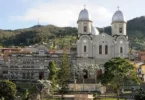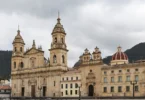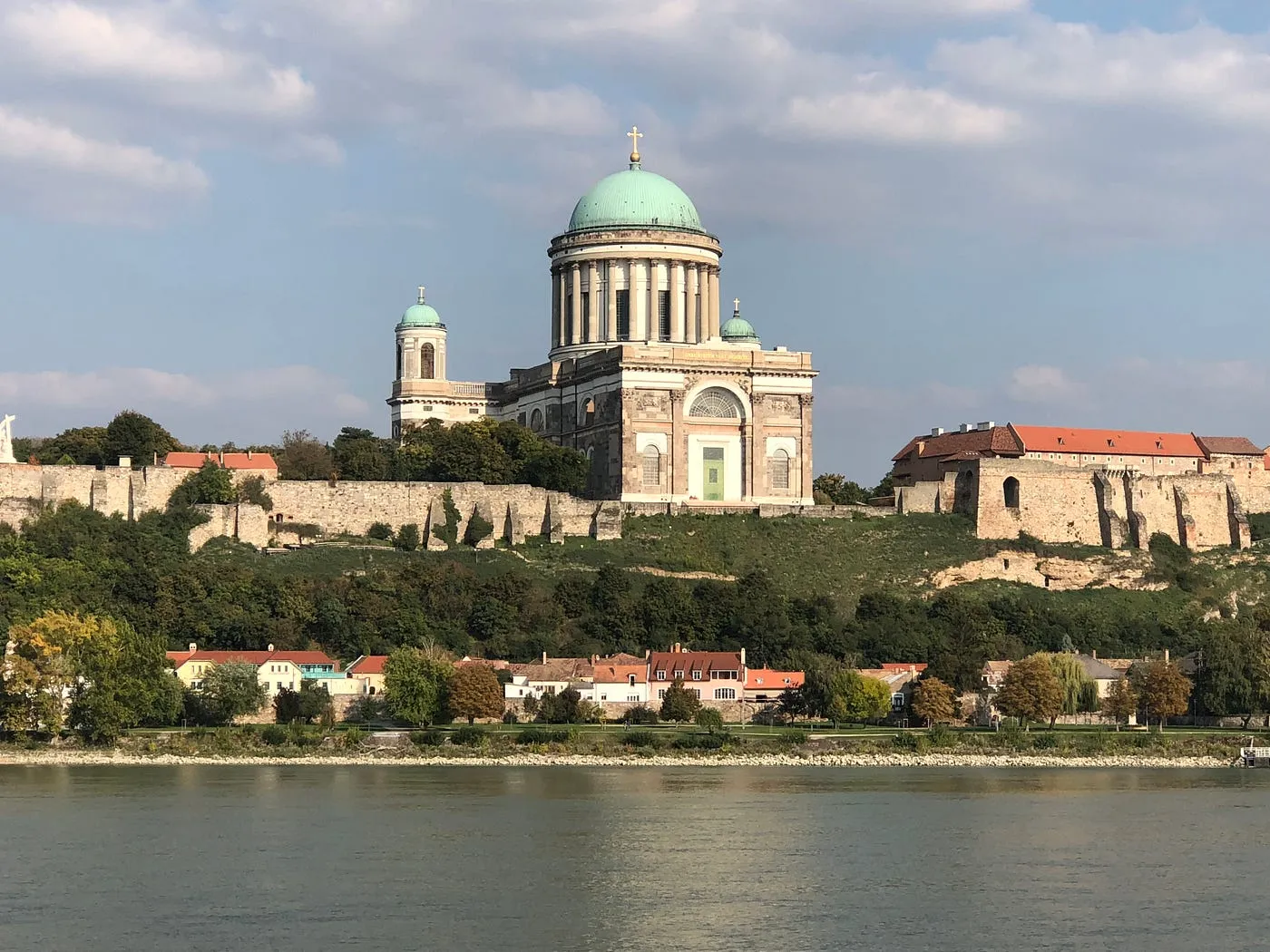
Introduction
The Primatial Basilica of the Assumption of the Blessed Virgin Mary and St Adalbert (Hungarian: Nagyboldogasszony és Szent Adalbert prímási főszékesegyház), also known as the Esztergom Basilica (Hungarian: Esztergomi bazilika), is an ecclesiastic basilica in Esztergom, Hungary, the mother church of the Archdiocese of Esztergom-Budapest, and the seat of the Catholic Church in Hungary. It is dedicated to the Assumption of Saint Mary and Saint Adalbert.
It is the largest church in Hungary. Its inner area is 5,600 m². It is 118 m long and 49 m wide. It has a reverberation time of more than 9 seconds. Its dome, forming a semi-sphere, is situated in the middle, and it has 12 windows. It is 71.5 m high inside (which makes it one of the tallest domes in the world), with a diameter of 33.5 metres, and is 100 m high from outside, the stairs count 400 steps counted from the crypt.
The huge crypt, built in Old Egyptian style in 1831, is today the resting place of late archbishops, among others, József Mindszenty, famous for his opposition to both Nazi and Communist rule.
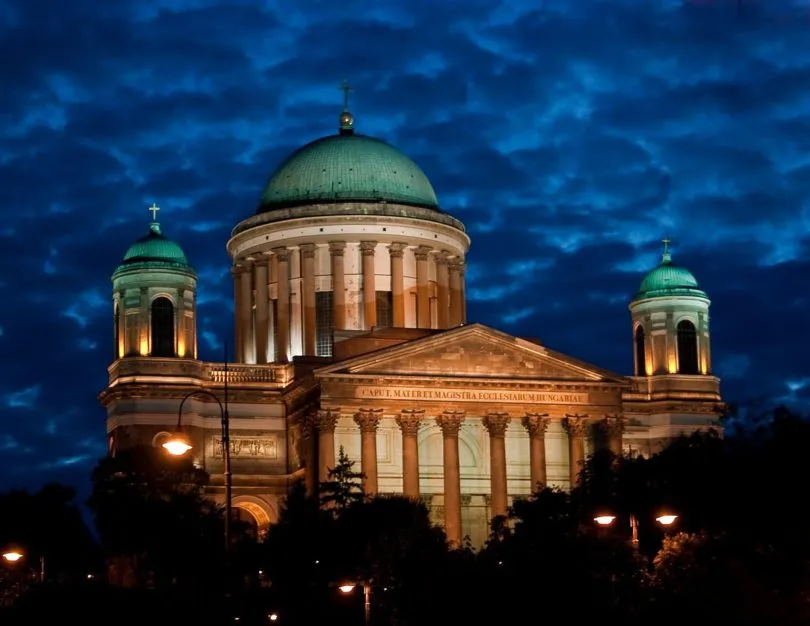
The core of medieval Esztergom, consisting of the Castle, the Royal City and the Water City, is the Castle, which was already the seat of Prince Géza’s reign with a fortified residence and a chapel named after St. István, the first martyr. Saint Stephen was born here, baptized and crowned here, and founded the archdiocese here. St. István handed over the princely residence to the archbishopric, built a new royal palace on the southern peak of the mountain, and in the middle of the mountain a church in honor of the Blessed Virgin and St. Adalbert.
Next to its vestibule is the monastery (chapter house), and to the north is the chapel of St. Stephen the Martyr, which was later enlarged and became the private church of the archbishop, and from 1391 it became the church of St. Stephen’s deanery and companion chapel. Around 1180, a fire destroys the Castle. The royal palace III. Béla, the St. Adalbert Church is restored with royal help by Archbishop Jób.
In 1256, Béla gave the entire Castle to the archbishops. From then on, its protection and maintenance is the concern and duty of the archbishops. The St. Adalbert Archbishop’s Cathedral was rebuilt by Csanád Telegdi, later Archbishop Dénes Szécsi, and consecrated by him in 1453 with the dual titles of Virgin Mary and St. Adalbert. The three-nave, 30 fathoms long, 10 fathoms wide huge cathedral is rightly and admiringly called “ecclesia magnifica”, which, in addition to its rich artistic training, is decorated with three towers, external and internal chapels with 12 altars.
In addition to the administration of the voluminous archbishopric province, pastoral care is also carried out in the Castle. The Martyr Szent István Church is the IV. It is the parish church of the inhabitants who were moved from the Royal City to the Castle by Béla in 1249. However, they moved back in 1256. The altar of the Holy Cross of the St. Adalbert Archbishop’s Cathedral is used for the pastoral functions of the parish.
The 1397 statute of the Esztergom chapter summarizes the duty of the rector of the Holy Cross Altar Canons as follows: “Ad rectorem pertinet cura animarum et ministratio sacramenti omnium commorantium in castro, capitulo et in scholis Strigoniensibus.” Reader Canon Mihály Kesztölczi (1469–1499) designed the St. Jerome’s Chapel in the north tower of the cathedral and established a foundation so that there would be a permanent confession service there.
After the Battle of Mohács, in which Primate László Szalkay also falls, the chapter moves from the Turks to Bratislava and then to Nagyszombat. The cathedral was already damaged during the 1543 siege. After the capture of the Castle, the Turks demolished its sanctuary for military reasons, crushed its interior decorations as idols, and used it as a mosque.
In 1594, during the battle to retake the Castle, the explosion of the gunpowder stored inside severely damaged it. The final liberation is worth it only in ruins. Only the Annuntiatio chapel of Archbishop Tamás Bakócz, built between 1506 and 1511, survived the destruction. After the recapture, the Te Deum was sung here, and the priests of the castle guard performed the service here.
In 1761, Mária Terézia returned the Castle to the archdiocese. From then on, the parish priests of Vízíváros were assigned the spiritual care of the residents of the Castle. Between 1768 and 1770, Mária Terézia built a baroque church in honor of St. Stephen in the middle of the Castle. Already during this construction, the ruins of the former, famous St. Adalbert’s Cathedral are being destroyed. They finally disappear under the prince-primates Ferenc Barkóczy (1761–65) and then Sándor Rudnay (1819–31) to make way for the construction of the new church, today’s primacy basilica.
The foundation stone of the huge building (5,660 m2) was laid in 1822 by Prince-Primate Sándor Rudnay. On August 31, 1856, Duke-Primate János Scitovszky consecrated it in honor of the Holy Virgin and Bishop Saint Adalbert, who were taken up to heaven. From 1856, the parish priest of the main cathedral is a member of the chapter.
The sanctuary of the parish functions is the Bakócz Chapel, which was rebuilt intact in the Basilica, and whose ancient icon has attracted pilgrims for a long time. The parish has been keeping its registers since 1822. Among the renovation works of recent years, the restoration of the roof structure above the eastern main nave after fire damage stands out. Monument, identification number 2350.
The monument-like statue of Mary standing near the southern tower of the Basilica was made by the wife of the city commander Ferenc Kuckländer in 1710, based on the Madonna of Altötting. The chapel of the Simor Papi Otthon (12 Dobozi M. u.) on the territory of the parish is used by the residents of the Otthon.The Basilica of Esztergom is the largest and most important church in Hungary. During the middle Ages it served as the royal cathedral of the Hungarian kings.
It had a rough history, being sacked by the armies of Bohemia in the 14th century and again by the Turks in the 16th century. After centuries of damage and neglect, the original cathedral was finally demolished and completely rebuilt in the mid-19th century. Throughout the Cold War, when Hungary lay behind the Iron Curtain, the Basilica remained a steadfast beacon of religious freedom. It is by far Hungary’s most popular place of Christian pilgrimage.
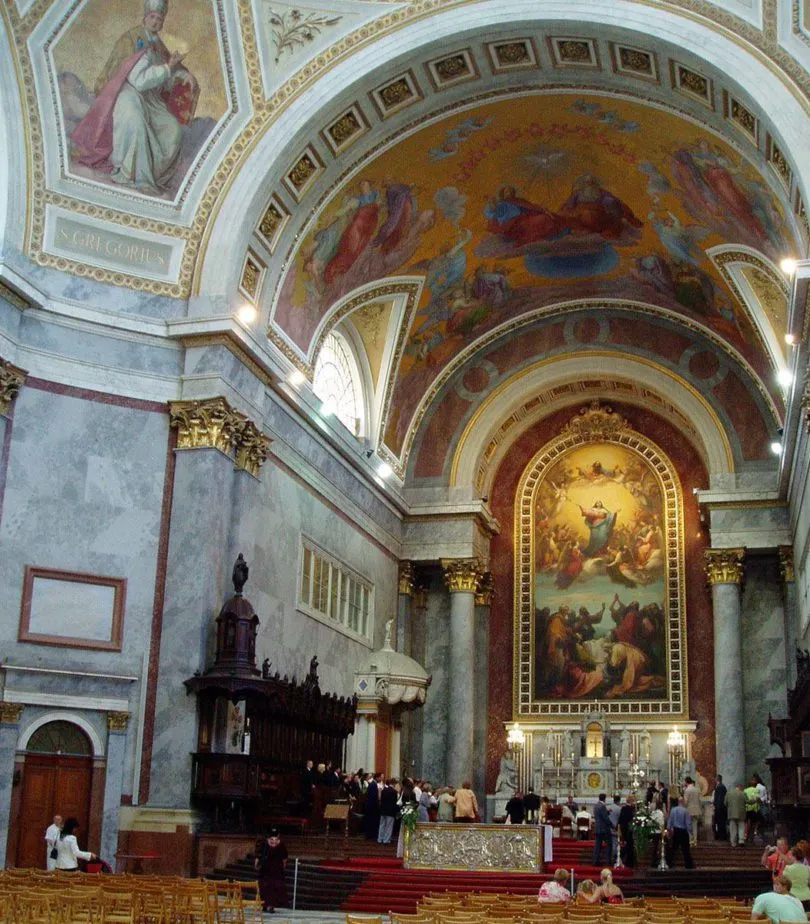
The largest church in Hungary sits on Castle Hill, and its 72m-high central dome can be seen for many kilometres around. The building of the present neoclassical church was begun in 1822 on the site of its 12th-century counterpart, which was destroyed by the Turks. József Hild, who designed the cathedral at Eger, was involved in the final stages, and the basilica was consecrated in 1856 with a sung Mass composed by Franz Liszt. Highlights include the dome, treasury and crypt.
Measuring 114m long and 47m wide, the grey church is colossal. Its highlight is the red-and-white marble Bakócz Chapel on the southeast side to the left of the main entrance which is a splendid example of Italian Renaissance stone carving and sculpture. The chapel escaped most though not all of the Turks’ vandalism; note the smashed-in face of Gabriel and the missing heads of other angels above the altar. The altar painting by Michelangelo Grigoletti (1854), modelled after a work by Titian, is said to be the world’s largest painting on a single canvas.
On the northwest side of the church are the 70 steps to the basilica’s treasury, an Aladdin’s cave of vestments and church plate in gold and silver, studded with jewels. It is the richest ecclesiastical collection in Hungary. From here it is worth making the tortuous climb up 360 more steps to the dome for outstanding views over the city. On the way you pass through the new Panorama Hall and café.
The door to the right as you enter the basilica leads to the crypt, a series of eerie vaults at the bottom of 50 steps, with tombs guarded by monoliths representing Mourning and Eternity. Among those at rest here are Cardinal József Mindszenty.
The architect was Pál Kühnel and the lead contractor was his nephew, János Packh. Because of the topography, main facade faces east. The foundation-stone was laid and work began in 1822. After Packh’s murder in 1839, József Hild was placed in charge of construction. In 1846, the cross was placed on the dome. Hild completed the building in Classicist style in 1869
The altarpiece (13.5 × 6.6 metres) by Girolamo Michelangelo Grigoletti, depicts the Assumption of the Blessed Virgin Mary. It was commissioned by Archbishop József Kopácsy.
The Cathedral Treasury is on the first floor. It opened in 1886 with the aim of preserving and displaying the liturgical instruments once used in the cathedral. It contains the “Matthias’ Calvary”, a 15th century golden cross for coronation oath from the Árpád era. Pope John Paul II used the Suki chalice for the Holy Mass, when he visited Esztergom in 1991.
The basilica is also known for Bakócz Chapel (named after Tamás Bakócz), built by Italian masters between 1506–1507 out of red marble of Süttő, its walls adorned with Tuscan Renaissance motifs. In 1823, the chapel was carefully disassembled (into about 1,600 pieces) and moved 20 metres away from its original location and attached to the new basilica. It is the most precious remaining example of Renaissance art in Hungary. A long staircase to the dome affords a panaramic view of the city.
The crypt of Esztergom Basilica is a significant and solemn space beneath the main body of the church. It serves as the final resting place for a number of notable individuals associated with the church. Crypts in large religious structures often hold the remains of bishops, archbishops, cardinals, and other religious dignitaries.
Seven Chapels
Seven churches are known from the Middle Ages on Castle Hill. The St. Adalbert Cathedral, which according to our written sources existed already around 1010, was located approximately on the site of today’s Basilica. To the North, next to the North Tower of today’s Basilica, was the St. Stephen Protomartyr Church, which was built by Prince Géza and chronologically was the first church in this place.
The third church was The Round Chapel from the time of St. Stephen discovered in the Árpád-házi royal palace. A certificate from 1284 mentions the Saint Vid chapel (the fourth church) located on the Castle Hill in Esztergom. The fifth church of medieval origin is also located in the Árpád-házi royal palace, it is III. Béla’s Castle Chapel.
The sixth outstanding masterpiece of Hungarian Renaissance architecture is the Bakócz Chapel, which was built in the 16th century. Since its relocation in 1823 it has been the Side Chapel of the Basilica.
The largest ecclesiastical construction of the first half of the 20th century was the Esztergom Cathedral. Between 1822-1869, four prince-primates built the classicist-style Basilica based on the plans of Pál Kühnel, János Packh, and then József Hild.
A model of the complex of buildings covering the Castle Hill, designed by Sándor Rudnay, can still be viewed in the Treasury of the Basilica. Unfortunately, the cathedral and the canon houses were realized from the large-scale plan only partially. The relocation of the Bakócz chapel is attributed to János Packh: in 1823 it was dismantled into 1600 parts, then changed its orientation and was included in the new cathedral and left for posterity.
The construction of the cathedral led by Packh was successful. After his murder in 1839, the main walls of the building, the four giant pillars supporting the future dome and the vaults connecting them were already built, and the vaulting of the altar was in progress. The construction was taken over by József Hild. The final form of the Basilica is thanks to him. In 1846, the cross was placed on the dome. When it was consecrated in 1856 with the “Missa solennis” composed for the occasion by Ferenc Liszt, the building was far from complete. The capstone was finally laid on November 1, 1869.
Artistic Treasures
The artistic treasures of the Esztergom Basilica are also impressive. The statue of the Virgin Mary, the mosaic in the anteroom, the Great Lady Altarpiece, the silver tombstones, and the small sculptures on the main altar are all treasures with historical and artistic significance. Therefore, if you like artistic treasures, then the Esztergom Basilica is not just beautiful, but also a special place from a cultural and historical point of view. Some of
1. Relic Exhibition and Gift Shop
The dome space of Esztergom Basilica houses a relic exhibition and a gift shop, likely offering visitors the chance to explore religious artifacts and purchase souvenirs.
2. Liturgical Textiles and Goldsmith Works
The treasury of Esztergom Basilica preserves liturgical textiles and goldsmith works used during coronations. This includes the coronation cross made of gold and precious stones, a pearl-covered bishop’s glass, and the shepherd’s staff of Archbishop Miklós Oláh.
3. Horn Goblets
Horn goblets from the 1528 treasury inventory were originally ornamental objects. Three horn goblets, including ones from the treasury of Czech King Wenceslas and a gift from János Corvin, were used to store holy oils.
4. Mátyás Calvary
The most valuable piece in the treasury is the Mátyás calvary made of about 5 kg of gold. It was a Gothic piece presented by Margaret of Flanders to her husband Fülöp Merész in 1403.
5. Enamel Chalice
A coiled enamel chalice from around 1437-1440, a gift to the Gyulafehérvár Cathedral, is a notable example of medieval Hungarian goldsmithing. It features finely crafted miniature figurines of religious figures.
6. Baroque Goldsmithing Examples
High-quality examples of Baroque goldsmithing include Imre Esterházy’s chalice and chalice made in Vienna, as well as Károly Ambrus’ chalice and chalice made in Augsburg.
7. Monstrance and Church Equipment
Primate Imre Esterházy presented a monstrance to the treasury in 1729. Habsburg Archbishop Károly Ambrus contributed to the treasury with chalices and mass jugs made by Augsburg goldsmith Johann Jacob Vogelhund.
8. Expansion in the 19th Century
In the 19th century, the treasury was expanded with significant donations from archbishops, art trade purchases by Archbishop János Simor, and the inclusion of the bequest of Arnold Ipolyi, Bishop of Nagyvárad.
9. Historicizing Wire Enamel Shepherd’s Staff
The treasury preserves a historicizing wire enamel shepherd’s staff presented by the city of Budapest in 1886 on the occasion of János Simor’s Golden Mass.
10. Pectoral Crosses, Chalices, and Rings
19th and 20th-century pectoral crosses, chalices, and rings from the legacy of the Esztergom canons are on display in the last stage of the permanent exhibition.
11.Objects of Notable Figures
Objects belonging to notable figures, including princes János Csernoch, Justiztinián Serédi, and József Mindszenty, close the historical presentation in the treasury.
The treasury of Esztergom Basilica is a repository of religious and historical artifacts, showcasing the cultural and artistic heritage associated with the basilica and the broader region. Visitors can explore a diverse collection that spans centuries and reflects the rich history of the church.
Annual Feast Day
April 23rd is the feast day of Saint Adalbert and August 15th is the feast day of Assumption of Saint Mary.
Mass Timing
Summer time
- Monday–Friday: 8:30 am
- Saturday: 18:00
- Sunday: 10:30 , 18:00
Winter time
- Monday–Friday: 8:30 am
- Saturday: 17:00
- Sunday: 10:30, 17:00
On the first Friday of the month, there is a mass in the evening: 6:00 pm., or 5:00 pm., during winter time.
Contact Info
Esztergom
Szent István tér 1
2500 Hungary
Phone No.
Phone: +36 33 402 354
Accomodations
How to reach the Sanctuary
Airways
The nearest airport to Esztergom Basilica is Budapest airport which is 82.3 kilometres away from the basilica.
Railways
The nearest railway station to Esztergom Basilica is Esztergom railway station which is 3.9 kilometres away from the basilica.


